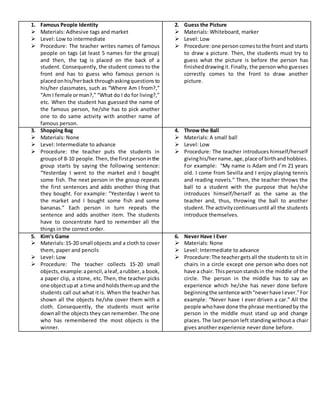Warming Up
•Download as DOCX, PDF•
0 likes•36 views
This document describes 6 different icebreaker activities for students at different levels: 1. Famous People Identity - Students try to guess which famous person's name is written on a tag taped to their back by asking yes or no questions to classmates. 2. Guess the Picture - One student comes up to draw a picture while others try to guess what it is before it's finished. 3. Shopping Bag - Students take turns repeating a sentence about items bought at the market, adding one more item each time. 4. Throw the Ball - A ball is tossed around as each student introduces themselves when they catch it. 5. Kim's Game - Students try to remember items the teacher shows
Report
Share
Report
Share

Recommended
Recommended
More Related Content
What's hot
What's hot (19)
Decisions, decisions, decisions presentation feb.2011

Decisions, decisions, decisions presentation feb.2011
Communicative teaching: what do PRC students think?

Communicative teaching: what do PRC students think?
Similar to Warming Up
Similar to Warming Up (20)
More from Esteban San Martín Marticorena
More from Esteban San Martín Marticorena (8)
Recently uploaded
https://app.box.com/s/4hfk1xwgxnova7f4dm37birdzflj806wGIÁO ÁN DẠY THÊM (KẾ HOẠCH BÀI BUỔI 2) - TIẾNG ANH 8 GLOBAL SUCCESS (2 CỘT) N...

GIÁO ÁN DẠY THÊM (KẾ HOẠCH BÀI BUỔI 2) - TIẾNG ANH 8 GLOBAL SUCCESS (2 CỘT) N...Nguyen Thanh Tu Collection
Recently uploaded (20)
Home assignment II on Spectroscopy 2024 Answers.pdf

Home assignment II on Spectroscopy 2024 Answers.pdf
Unit 8 - Information and Communication Technology (Paper I).pdf

Unit 8 - Information and Communication Technology (Paper I).pdf
Basic phrases for greeting and assisting costumers

Basic phrases for greeting and assisting costumers
Extraction Of Natural Dye From Beetroot (Beta Vulgaris) And Preparation Of He...

Extraction Of Natural Dye From Beetroot (Beta Vulgaris) And Preparation Of He...
Instructions for Submissions thorugh G- Classroom.pptx

Instructions for Submissions thorugh G- Classroom.pptx
Jose-Rizal-and-Philippine-Nationalism-National-Symbol-2.pptx

Jose-Rizal-and-Philippine-Nationalism-National-Symbol-2.pptx
MARUTI SUZUKI- A Successful Joint Venture in India.pptx

MARUTI SUZUKI- A Successful Joint Venture in India.pptx
2024.06.01 Introducing a competency framework for languag learning materials ...

2024.06.01 Introducing a competency framework for languag learning materials ...
GIÁO ÁN DẠY THÊM (KẾ HOẠCH BÀI BUỔI 2) - TIẾNG ANH 8 GLOBAL SUCCESS (2 CỘT) N...

GIÁO ÁN DẠY THÊM (KẾ HOẠCH BÀI BUỔI 2) - TIẾNG ANH 8 GLOBAL SUCCESS (2 CỘT) N...
Warming Up
- 1. 1. Famous People Identity Materials: Adhesive tags and market Level: Low to intermediate Procedure: The teacher writes names of famous people on tags (at least 5 names for the group) and then, the tag is placed on the back of a student. Consequently, the student comes to the front and has to guess who famous person is placedonhis/herback throughaskingquestions to his/her classmates, such as “Where Am I from?,” “Am I female orman?,” “What do I do for living?,” etc. When the student has guessed the name of the famous person, he/she has to pick another one to do same activity with another name of famous person. 2. Guess the Picture Materials: Whiteboard, marker Level: Low Procedure:one person comestothe front and starts to draw a picture. Then, the students must try to guess what the picture is before the person has finisheddrawingit.Finally, the person who guesses correctly comes to the front to draw another picture. 3. Shopping Bag Materials: None Level: Intermediate to advance Procedure: the teacher puts the students in groupsof 8-10 people.Then,the firstpersoninthe group starts by saying the following sentence: “Yesterday I went to the market and I bought some fish. The next person in the group repeats the first sentences and adds another thing that they bought. For example: ”Yesterday I went to the market and I bought some fish and some bananas.” Each person in turn repeats the sentence and adds another item. The students have to concentrate hard to remember all the things in the correct order. 4. Throw the Ball Materials: A small ball Level: Low Procedure: The teacher introduces himself/herself givinghis/hername,age,place of birthandhobbies. For example: “My name is Adam and I’m 21 years old. I come from Sevilla and I enjoy playing tennis and reading novels.” Then, the teacher throws the ball to a student with the purpose that he/she introduces himself/herself as the same as the teacher and, thus, throwing the ball to another student. The activitycontinuesuntil all the students introduce themselves. 5. Kim’s Game Materials:15-20 small objects and a cloth to cover them, paper and pencils Level: Low Procedure: The teacher collects 15-20 small objects,example:apencil,aleaf,arubber,a book, a paper clip, a stone, etc. Then, the teacher picks one objectupat a time andholdsthemup and the students call out what it is. When the teacher has shown all the objects he/she cover them with a cloth. Consequently, the students must write downall the objects they can remember. The one who has remembered the most objects is the winner. 6. Never Have I Ever Materials: None Level: Intermediate to advance Procedure:The teachergetsall the students to sit in chairs in a circle except one person who does not have a chair. Thispersonstandsin the middle of the circle. The person in the middle has to say an experience which he/she has never done before beginningthe sentence with“neverhave Iever.”For example: “Never have I ever driven a car.” All the people whohave done the phrase mentionedby the person in the middle must stand up and change places. The last person left standing without a chair gives another experience never done before.